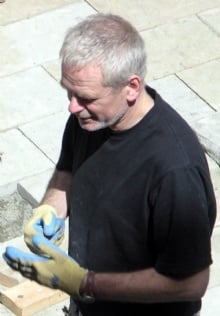"I'm cautious about using fire. It can become theatrical. I am interested in the heat, not the flames"
About this Quote
Andy Goldsworthy draws a line between spectacle and substance, warning how easily an elemental force becomes a performance. Fire is an obvious attention-catcher; flames command the eye, dominate space, and risk turning nature into a stage set. By privileging heat over flame, he points to the quieter, transformative energies that work beneath appearances, forces that bind, soften, cure, crack, melt, and temper materials over time. Heat acts; flame distracts.
The distinction reveals a philosophy of making that resists theatrics in favor of intimacy with process. Goldsworthy’s practice often collaborates with weather and geology, ice fused at dawn, frost melted by breath or sunlight, stones shifted by tide, leaves arranged by wind’s direction. In this register, heat aligns with gravity, erosion, and thaw: subtle, persistent powers that shape forms without showiness. The artwork is not a stage effect but an index of change, a record of the world’s work on itself.
There is also an ethics here. Flames scorch and declare; they can scar a landscape and claim attention through danger and dazzle. Heat, by contrast, suggests care and duration, warming, drying, darkening wood into charcoal, coaxing materials rather than consuming them. It privileges touch over glare, closeness over spectacle, the body’s knowledge of warmth rather than the eye’s fixation on flicker. The viewer is invited to attend to what is happening rather than merely what is happening loudly.
In an art world often drawn to the instantaneous and spectacular, choosing heat is choosing time. It is a preference for processes that leave subtle traces: the seam where ice has fused, the tension in a bent twig, the patina on stone. By avoiding theatrics, Goldsworthy clears space for the elemental to be felt rather than displayed. Heat becomes a metaphor for the underlying energies that matter, the quiet work that changes things, sustains life, and reveals form, while flames stand in for the noise that too easily steals the meaning from change.
About the Author

